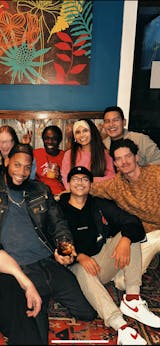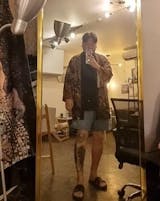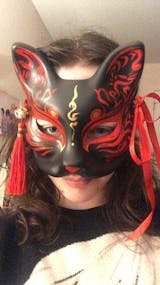I am not the type of person to write reviews but here it goes.
I really needed the clothes for an unexpected party but I chose the fast delivery option and I should say I’m impressed by their fast delivery. The product matches the pictures displayed and I’m impressed by the quality. Kudos to Eiyo Kimono.
Filters
What are Oni Masks?

Masks are prominent in Japanese culture, and they are used extensively in theatres. These masks cover the whole face and might incorporate elements from animals. Shrine festivals, New Year's, and Shinto dances are events where participants wear masks exclusively. In theatres, the actors wear masks to portray intense emotions and add depth to the play, but the audience can also wear similar masks to show their appreciation of the performance.
Why are Masks so Important in Japan?
Noh Drama is used to refer to classical Japanese theatre as it usually uses Buddhist elements. The shows performed in Noh theatres are usually quite dramatic and musical, often including music and heavy costumes. The costumes can include elaborate masks to heighten their characters and showcase the story to the audience. Noh masks are split into five categories: demons, gods, men, women, and the elderly. The mask does not change its expression, so the actor's job is to bring life to the play through their skills. The nation's folklore inspires Japanese masks, and so, they have a mythical quality that seems enchanting to outsiders.
Noh masks are usually made of light materials as actors need to wear them for hour-long performances. They are usually made of bamboo, wood, or paper. The masks have small holes for the eyes and nose for breathing. These masks are powerful in dramatizing the story and evoking emotion from the audience. Sometimes, the mask's design can be so complex that the expression on it changes depending on the light and angle it is placed in. The masks also help the actor feel closer to their character and play them efficiently.
Oni Masks and Their Origins in Japanese Theatre
The word, Oni, holds a deep significance in Japanese folklore. It means demons and masks dedicated to this creature were originated in the Noh theatre. The creatures get their name from the Japanese character 'On,' which means hiding or remaining in the shadows. For the Oni, this description fits as they are supposed to be invisible, and no human eye can see them. In some tales, Oni is considered the bringers of death and disease and harboring other evil events. The Oni can also take on various forms to further deceive their viewers, and sometimes, masks dedicated to them are colored in light blue instead of red. Oni masks used in Japanese theatre are sometimes similar to Hannya masks, as they both portray evil forms.
Oni masks are usually colored in deep red, with exaggerated features to draw fear from the audience and give the show a somber atmosphere. The masks make the actor wearing them look terrifying and forbidding, as the expression on the Oni mask is permanently angry with sharp teeth. Although Oni masks can seem frightening, they are not the most troublesome supernatural creatures in Japanese folklore. Other mischief-causing demons such as Tengu and Jorugomo are generally considered far scarier.
Oni is categorized into yokai, which is Japanese for spirit or legend. Therefore, the Oni is also a yokai, a mythical being with a bad temperament and lives in the spirit world. Oni is famous in most Japanese legends, as their unique personality serves as the embodiment of evil and succeeds at intimidating the readers. Along with other mythical personalities in Japan, such as Kitsune, Yurei, and Kappa, the Oni is legendary. It should also be noted that each depiction of Oni may vary from the previous. Their portrayal also depends on the region and audience, but most Oni is similar in Japanese theatres.
Other Occasions of Wearing the Oni Mask
The bean throwing ceremony in Japan, also known as Setsubun, is a cultural festival that celebrates the day before spring. The Japanese take this event very seriously, and it is known to cleanse the people of evil spirits before spring comes. There are a variety of rituals to be performed to drive away bad fortunes and give participants a new beginning. At this ceremony, the Japanese usually throw soybeans at an Oni figure, which symbolizes removing negative energy from their towns and households. The beans are also thought to be harmful to Oni, so they are an effective weapon against the creatures. Participants can wear Oni masks themselves or have a figure built bearing the mask. Sometimes, the Oni mask is worn on visiting shrines or places of worship. Although this practice may seem disrespectful, the idea is to rid the shrine of any evil force that may reside in it.
How Should Oni be Described?
As mentioned previously, all descriptions of Oni might vary from one another. However, they must have in common to look outrageously evil and angry. Usually, this feat is achieved by painting the masks a deep burgundy, in some cases even black, and drawing vicious eyebrows over the eyes. Oni is ugly and not meant to look appealing in any way, and the idea is that the audience or reader must be repelled by its hideous appearance. Aside from the facial description, Oni must also be tall and have a misshapen body, resembling a giant. In certain stories, they look like ogres that bring ill fortune over anyone who interacts with them and serve as a symbol for wickedness.
An Oni's hair is unkempt and dark, with wild strands sticking out from everywhere. Their claws are sharp, as are their teeth, and they usually have two large horns poking out from their temples. The horns are meant to show a resemblance to the devil and the creature's mythical origin. Although the Oni may seem slightly humanoid from these descriptions, their features are nothing like those of a human. The Oni might have more than the usual number of eyes and extra fingers or toes in certain shows. The creature's clothing is mostly a one-piece garment made from tigerskin. They also carry an iron club to terrorize their viewers, known as kanabo in Japanese. This illustration helped create the famous expression in Japanese, 'Oni with an iron club.' To say this phrase at someone means they are invincible and enormously powerful.





























